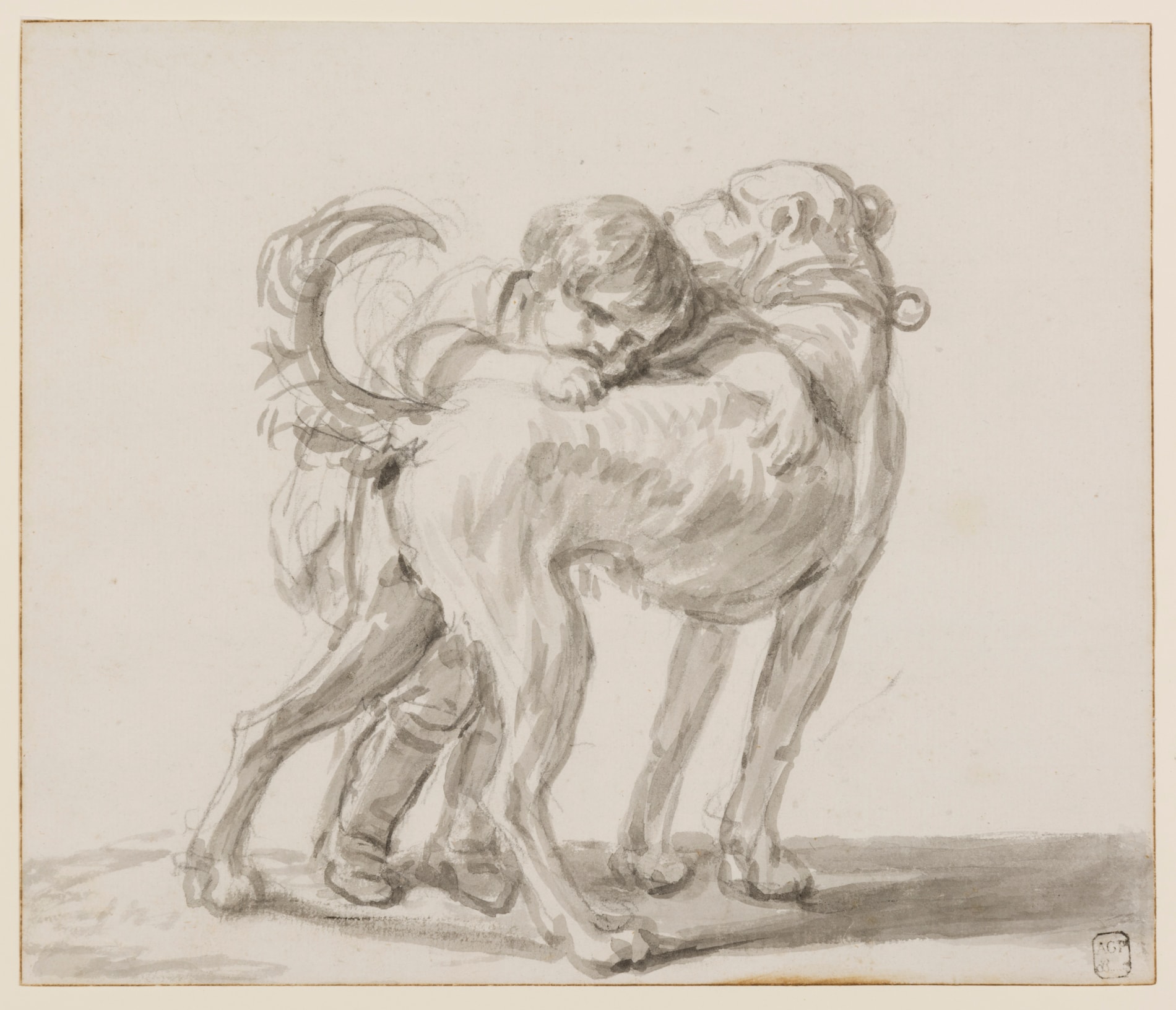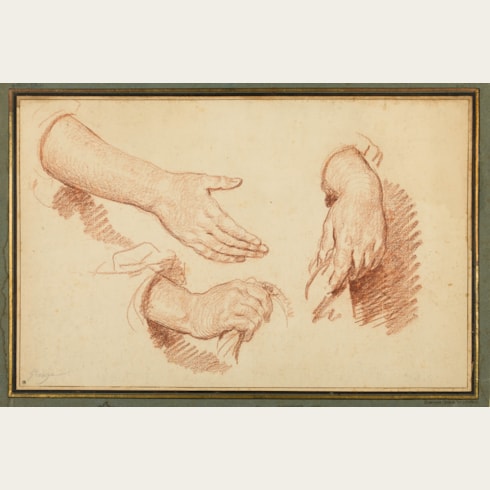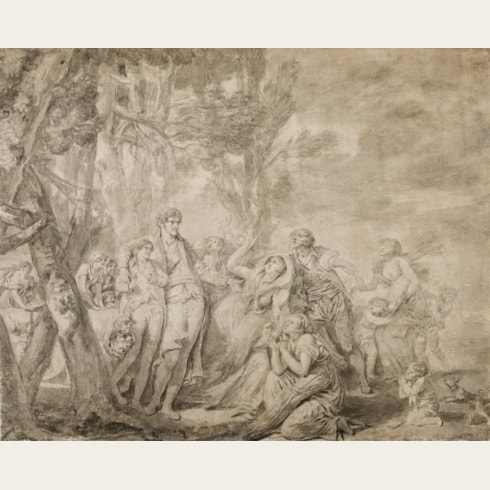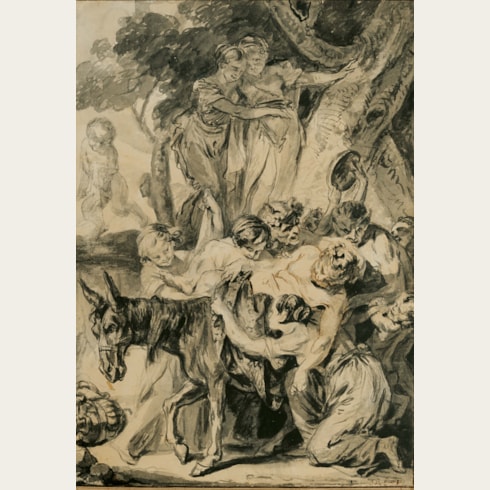Jean-Baptiste GREUZE
(Tournus 1725 - Paris 1805)
A Child Hugging a Dog
Sold
0 x 0 cm (0 x 0 inches)
This charming sheet, drawn in Greuze's favoured medium for compositional studies of brush and grey-black wash, is a study for the little boy embracing a dog at the right edge of a large compositional drawing entitled The Family Reconciliation (La réconciliation de la famille) of c.1770, in the collection of the Phoenix Art Museuma. It has been suggested that the Phoenix drawing was one of a pair of very large and highly finished genre drawings executed in brush and grey wash, together with its pendant, The Angry Wife (La Femme colère), today in the Metropolitan Museum of Art in New York. Probably executed both as finished drawings for sale and as designs for engravings, these two large drawings are thought to have been inspired by Greuze’s somewhat tempestuous family life, and the dog depicted in this drawing may have been a family pet.
In an earlier version of the composition of The Family Reconciliation, today in the Prat collection in Paris, the dog is absent, and the child is seen standing at a table. Another, much more sketchy compositional study for The Family Reconciliation, today in the Snite Museum of Art at the University of Notre Dame in Indiana, also excludes the dog. A very similar child and dog is also found in a large, finished drawing of The Paternal Blessing, or the Departure of Basile, exhibited at the Salon of 1769 and today in the Art Institute of Chicago. The dog in the Chicago drawing, however, faces to the left.
Dogs appear often in Greuze’s paintings and finished drawings, and the artist seems to have had a particular affection for them. Several studies of dogs were recorded in the sale of the contents of the artist’s studio in 1843, following the death of his daughter Caroline, and others are noted in Jean Martin and Charles Masson’s catalogue raisonné of Greuze’s work, published in 1908.
The first recorded owner of this drawing was Comte A. G. P. de Bizemont Prunelé (1752-1837) who, apart from being a collector of drawings, paintings and objets d’art, was also a talented amateur artist and engraver. He studied with Charles-Nicolas Cochin and produced some 150 engravings and a number of landscapes, including several views of Orléans. A number of drawings from his collection were left to the Musée des Beaux-Arts in Orléans. Although it does not bear his collector’s mark, this drawing may have later belonged tothe Parisian marchand-amateur Émile Louis Dominique Calando (1840-1898), since a pen and ink drawing closely matching its description was listed in the catalogue of the posthumous sale of his collection of mainly 18th century French drawings held in December 1899, which included ten sheets by Greuze.
In an earlier version of the composition of The Family Reconciliation, today in the Prat collection in Paris, the dog is absent, and the child is seen standing at a table. Another, much more sketchy compositional study for The Family Reconciliation, today in the Snite Museum of Art at the University of Notre Dame in Indiana, also excludes the dog. A very similar child and dog is also found in a large, finished drawing of The Paternal Blessing, or the Departure of Basile, exhibited at the Salon of 1769 and today in the Art Institute of Chicago. The dog in the Chicago drawing, however, faces to the left.
Dogs appear often in Greuze’s paintings and finished drawings, and the artist seems to have had a particular affection for them. Several studies of dogs were recorded in the sale of the contents of the artist’s studio in 1843, following the death of his daughter Caroline, and others are noted in Jean Martin and Charles Masson’s catalogue raisonné of Greuze’s work, published in 1908.
The first recorded owner of this drawing was Comte A. G. P. de Bizemont Prunelé (1752-1837) who, apart from being a collector of drawings, paintings and objets d’art, was also a talented amateur artist and engraver. He studied with Charles-Nicolas Cochin and produced some 150 engravings and a number of landscapes, including several views of Orléans. A number of drawings from his collection were left to the Musée des Beaux-Arts in Orléans. Although it does not bear his collector’s mark, this drawing may have later belonged tothe Parisian marchand-amateur Émile Louis Dominique Calando (1840-1898), since a pen and ink drawing closely matching its description was listed in the catalogue of the posthumous sale of his collection of mainly 18th century French drawings held in December 1899, which included ten sheets by Greuze.
Following a period of study in Lyon, Jean-Baptiste Greuze arrived in Paris sometime in the early 1750s and began studying drawing with Charles-Joseph Natoire and Louis de Sylvestre. Very little is known of the artist’s early Parisian period, however. He was admitted into the Académie Royale as an associate member in 1755, in the category of peintre de genre particulier, and the same year exhibited several works at the Salon with some success, with three of the paintings acquired by the influential collector Ange Laurent de La Live de Jully. (Greuze did not, however, supply a morceau de recéption to the Académie, which was required in order to gain full membership as an Academician, until 1769.) In September 1755 the young artist travelled to Italy with another influential patron, the Abbé Gougenot, and he worked in Rome, mainly on portrait commissions and genre paintings, until the spring of 1757. Greuze’s paintings of moralizing genre subjects, exhibited at the biennial Salons from 1761, earned him the praise of the influential critic Denis Diderot. He was also a fine portraitist, exhibiting a number of portraits at the Salon throughout the 1760s to considerable acclaim.
While Greuze enjoyed the patronage of such prominent collectors as La Live de Jully, Madame de Pompadour and her brother, the Marquis de Marigny, Jean de Jullienne, the Duc de Choiseul and the Empress Catherine II of Russia, his difficult temperament often alienated other clients. (Indeed, even the artist’s great champion Diderot, writing to the sculptor Etienne Falconet in 1767, described Greuze as ‘an excellent artist but a bad-tempered fellow. One should collect his drawings and his pictures and otherwise leave him alone.’) Notwithstanding his success as a painter of genre subjects and portraits, Greuze always aspired to be recognized as a history painter. Throughout the 1760s he had considered various themes for his long-overdue morceau de reception for the Académie Royale, which he wanted to be of a mythological, Biblical or historical subject. In 1769, some fourteen years after he was agrée at the Académie, he finally submitted a painting of Septimus Severus Reproaching Caracalla as his reception piece. However, the work was rejected by the Académie, who instead admitted the artist only as a genre painter. Angered and humiliated by this snub, Greuze henceforth refused to exhibit at the Salons, choosing instead to show his paintings in his studio in the Louvre, where they attracted a good deal of public interest. He continued to enjoy considerable success throughout the 1770s and 1780s, especially among Russian patrons, and also profited from the sale of prints after his works. His reputation began to suffer in the years after the Revolution and with the rise of Neoclassicism, although by 1800 he had returned to exhibiting his works at the Salon, after an absence of thirty-one years, and continued to do so until 1804, when among the works he showed was a fine self-portrait. Greuze died, in his studio, at the age of nearly eighty, and was buried in the cemetery of Montmartre.
Greuze was a gifted and versatile draughtsman, equally adept in chalk, pastel and ink. From 1757 onwards he regularly showed finished drawings as well as oil paintings at the Salons, and one critic, writing of the 1761 exhibition, noted ‘Several drawings by M. Greuze...do him as much honour by their execution as by the choice and genius of their invention.’ The artist’s drawings were also often praised by Diderot, who noted that ‘this man draws like an angel…He is enthusiastic about his art: he makes endless studies; he spares neither care nor expenses in order to have the models that suit him.’ Greuze produced many preparatory studies, including compositional studies in pen and ink and head, hand and figure studies in chalk, for each of his painted compositions. A particular interest was the study of physiognomy and facial expression, made manifest through large-scale drawings of têtes d’expression. These drawings of heads, usually in red chalk, allowed the artist to refine the facial types and expressions that were such an important part of his paintings, but they were also produced as independent works of art, to be sold to collectors. Indeed, Greuze enjoyed a healthy market for his finished drawings; as the 18th century collector and connoisseur Pierre-Jean Mariette noted of him, ‘Il a fait aussi nombre de desseins, qui, dans le commencement, lui ont été payés prodigieusement par quelque curieux.’ Greuze’s drawings found their way into important 18th century collections in France, Russia and Germany, while several fellow artists, including Aignan-Thomas Desfriches, Claude Hoin, Joseph-Marie Vien and Johann Georg Wille, owned drawings by him.
While Greuze enjoyed the patronage of such prominent collectors as La Live de Jully, Madame de Pompadour and her brother, the Marquis de Marigny, Jean de Jullienne, the Duc de Choiseul and the Empress Catherine II of Russia, his difficult temperament often alienated other clients. (Indeed, even the artist’s great champion Diderot, writing to the sculptor Etienne Falconet in 1767, described Greuze as ‘an excellent artist but a bad-tempered fellow. One should collect his drawings and his pictures and otherwise leave him alone.’) Notwithstanding his success as a painter of genre subjects and portraits, Greuze always aspired to be recognized as a history painter. Throughout the 1760s he had considered various themes for his long-overdue morceau de reception for the Académie Royale, which he wanted to be of a mythological, Biblical or historical subject. In 1769, some fourteen years after he was agrée at the Académie, he finally submitted a painting of Septimus Severus Reproaching Caracalla as his reception piece. However, the work was rejected by the Académie, who instead admitted the artist only as a genre painter. Angered and humiliated by this snub, Greuze henceforth refused to exhibit at the Salons, choosing instead to show his paintings in his studio in the Louvre, where they attracted a good deal of public interest. He continued to enjoy considerable success throughout the 1770s and 1780s, especially among Russian patrons, and also profited from the sale of prints after his works. His reputation began to suffer in the years after the Revolution and with the rise of Neoclassicism, although by 1800 he had returned to exhibiting his works at the Salon, after an absence of thirty-one years, and continued to do so until 1804, when among the works he showed was a fine self-portrait. Greuze died, in his studio, at the age of nearly eighty, and was buried in the cemetery of Montmartre.
Greuze was a gifted and versatile draughtsman, equally adept in chalk, pastel and ink. From 1757 onwards he regularly showed finished drawings as well as oil paintings at the Salons, and one critic, writing of the 1761 exhibition, noted ‘Several drawings by M. Greuze...do him as much honour by their execution as by the choice and genius of their invention.’ The artist’s drawings were also often praised by Diderot, who noted that ‘this man draws like an angel…He is enthusiastic about his art: he makes endless studies; he spares neither care nor expenses in order to have the models that suit him.’ Greuze produced many preparatory studies, including compositional studies in pen and ink and head, hand and figure studies in chalk, for each of his painted compositions. A particular interest was the study of physiognomy and facial expression, made manifest through large-scale drawings of têtes d’expression. These drawings of heads, usually in red chalk, allowed the artist to refine the facial types and expressions that were such an important part of his paintings, but they were also produced as independent works of art, to be sold to collectors. Indeed, Greuze enjoyed a healthy market for his finished drawings; as the 18th century collector and connoisseur Pierre-Jean Mariette noted of him, ‘Il a fait aussi nombre de desseins, qui, dans le commencement, lui ont été payés prodigieusement par quelque curieux.’ Greuze’s drawings found their way into important 18th century collections in France, Russia and Germany, while several fellow artists, including Aignan-Thomas Desfriches, Claude Hoin, Joseph-Marie Vien and Johann Georg Wille, owned drawings by him.
Provenance
Comte André-Gaspard-Parfait de Bizemont Prunelé, Orléans (Lugt 128)
By descent to either his son, Adrien de Bizemont, Orléans, or his daughter, the Comtesse de Candé
Possibly Émile Louis Dominique Calando, Paris
Possibly his posthumous sale, Paris, Hôtel des Commissaires-Priseurs, 11-12 December 1899, lot 82 (‘Enfant caressant un chien. Superbe esquisse à l’encre de chine. (H, 0,205. – L. 0,290.)’, sold for 400 francs)
Anonymous sale, Paris, Hôtel Drouot, 29-30 November 1989, lot 63
Kate de Rothschild and Yvonne Tan Bunzl, London, in 1990
Private collection, since 1996.
By descent to either his son, Adrien de Bizemont, Orléans, or his daughter, the Comtesse de Candé
Possibly Émile Louis Dominique Calando, Paris
Possibly his posthumous sale, Paris, Hôtel des Commissaires-Priseurs, 11-12 December 1899, lot 82 (‘Enfant caressant un chien. Superbe esquisse à l’encre de chine. (H, 0,205. – L. 0,290.)’, sold for 400 francs)
Anonymous sale, Paris, Hôtel Drouot, 29-30 November 1989, lot 63
Kate de Rothschild and Yvonne Tan Bunzl, London, in 1990
Private collection, since 1996.
Literature
Possibly Jean Martin and Charles Masson, Catalogue raisonné de l'œuvre peint et dessiné de Jean-Baptiste Greuze, Paris, 1908, p.65, no.1043 (‘Enfant caressant un chien. H. 0m20. L. 0m29. – Esquisse à l’encre de Chine. Vente E. Calando, 12 décembre 1899, no. 82.’); London, Kate de Rothschild and Yvonne Tan Bunzl, Master Drawings, 1990, unpaginated, no.30; Kate de Rothschild, Kate de Rothschild: Master Drawings. A Celebration, 35 Years in the Art World 1972-2007, n.d. (2008), unpaginated, no.26; Clifford S. Ackley, ‘Master drawings from the collection of Horace Wood Brock’, The Magazine Antiques, February 2009, p.55, illustrated p.59, fig.11; Horace Wood Brock, Martin P. Levy and Clifford S. Ackley, Splendor and Elegance: European Decorative Arts and Drawings from the Horace Wood Brock Collection, exhibition catalogue, Boston, 2009, p.156, no.110, illustrated p.112; Antoine Chatelain, Greuze, l’enfance et la famille, exhibition catalogue, Paris, 2024, p.145, no.15, illustrated p.65.
Exhibition
London, Kate de Rothschild and Yvonne Tan Bunzl at Didier Aaron (London) Ltd., Master Drawings, 1990, no.30; Stanford University, Cantor Center for Visual Arts, Classic Taste: Drawings and Decorative Arts from the Collection of Horace Brock, March-May, 2000; Los Angeles, J. Paul Getty Museum, French Drawings from the Age of Greuze, 2002; Boston, Museum of Fine Arts, Splendor and Elegance: European Decorative Arts and Drawings from the Horace Wood Brock Collection, 2009, no.110; Paris, Galerie Eric Coatalem, Greuze, l’enfance et la famille, 2024, no.15.







